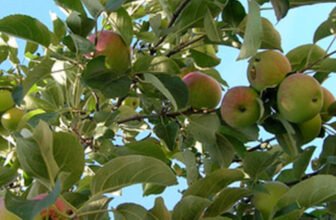
[ad_1]
Meyer lemon trees are a delightful addition to any home garden, offering both lush foliage and tangy fruits. But to ensure your tree thrives, fertilization is key. Let’s dive into the essentials of feeding your Meyer lemon tree for the best results.

Fertilizer: The Citrus Tree’s Best Friend
When it comes to fertilizing Meyer lemon trees, balance is the name of the game. A fertilizer with a balanced NPK ratio, such as 10-10-10 or 14-7-14, is ideal. During the growing season, which spans from early spring to fall, your tree craves nutrients. A high-nitrogen fertilizer or a slow-release all-purpose fertilizer will do wonders.
For those who prefer organic options, products like Organic Premium Kelp Seaweed Concentrate are perfect. They not only feed the tree but also enrich the soil with beneficial microorganisms. More on Kelp Seaweed.
Fertilizing Schedule
| Season | Fertilizer Type | Frequency |
|---|---|---|
| Early Spring | High-Nitrogen or Balanced | Once |
| Early Summer | High-Nitrogen or Balanced | Once |
| Late Summer | High-Nitrogen or Balanced | Once |
| Fall | High-Nitrogen or Balanced | Once |
Remember, the key is to avoid over-fertilization. Too much nitrogen can lead to lush leaves at the expense of fruit production.
Real-Life Example: The Potted Meyer Lemon
Consider a potted Meyer lemon tree on a sunny patio. It’s fertilized monthly with an organic balanced liquid blend, ensuring a steady supply of nutrients without overwhelming the plant. The result? A healthy tree that’s both a visual treat and a source of home-grown lemons.
Expert Tips for Meyer Lemon Success
- Sunlight: Meyer lemon trees need at least six hours of direct sunlight daily.
- Watering: Keep the soil moist but not soggy to prevent root rot.
- Temperature: Protect your tree from extreme cold by bringing potted trees indoors.
- Patience: Allow fruits to mature fully, which can take about six months.
By following these tips and using the right fertilizer, your Meyer lemon tree will be a source of pride and delicious fruit for years to come. Embrace the joy of gardening and watch as your Meyer lemon tree becomes a centerpiece in your garden or home.


How Can I Tell If My Meyer Lemon Tree Is Healthy?
To determine if your Meyer lemon tree is healthy, you should look for several key indicators:
- Leaves: Healthy Meyer lemon trees have vibrant, green leaves. Yellowing leaves or a general look of despair can be signs of overwatering, which can lead to root rot. Yellow leaves with green veins can indicate nutrient deficiencies.
- Root Health: Overwatering is a common issue that can lead to root rot. If the soil is soggy, it’s a sign that the tree is getting too much water. Let the soil dry out before watering again.
- Blossoms and Fruits: A healthy Meyer lemon tree will often be blooming or fruiting. If your tree is not producing flowers or fruit, it may be a sign that it’s not getting the nutrients it needs.
- Branches: When pruning your Meyer lemon tree, look for branches that are growing straight upwards. These are generally not fruit-producing branches. Also, remove any damaged or crossing branches.
- Disease and Pests: Watch for unusual leaf spots or bark that is too easy to peel. These can be signs of disease. If you notice pests, treat the tree with insecticidal soap or neem oil.
- Light and Temperature: Meyer lemon trees need at least six hours of direct sunlight daily and prefer warmer temperatures. If your tree is not getting enough light or is exposed to incorrect temperatures, it can affect its health.
Remember, consistency is key when caring for a Meyer lemon tree. Regular watering (without overwatering), proper fertilization, and adequate sunlight can help ensure your tree stays healthy.
[ad_2]






